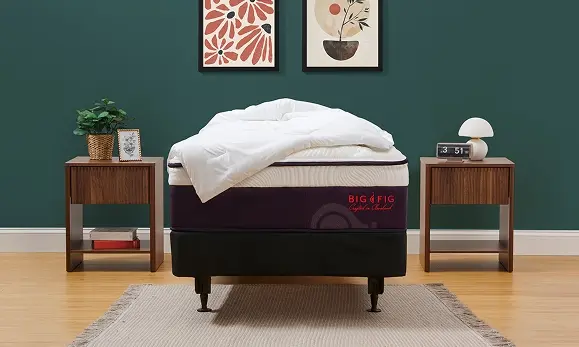For some dreamers, the slightest noise wakes them up at night. For others, the wailing siren of a passing fire truck doesn’t disturb their slumber (and we are SO JEALOUS). Just why, though, remains a bit of a mystery.
Although many people are self-proclaimed heavy or light sleepers, scientists have found little about why people react differently to noises and other stimuli during sleep. Lifestyle choices, genetics, and undiagnosed sleep disorders may play a role, but to this day, sleep experts are still stumped. And yes, there are sleep experts out there who dedicate their whole lives to sleep — we know, we’re jealous too.
In this article, we’ll explain the different sleep stages, cover the differences between heavy and light sleepers, provide awesome tips for those looking to snooze a little more soundly and define what a good night’s rest should look like.
So grab your coffee (or not, if you plan to sleep) and get comfortable — let’s dive in!
What are the Stages of Sleep?
Did you know that we cycle throughtwo main stages of sleep throughout the night? That’s right. These two stages are known as non-rapid eye movement (NREM) and rapid eye movement (REM). We’re about to give you an info dump about sleep science, so if you want the fundamental distinction, just remember that REM sleep is when your eyelids go all twitchy. If you’ve ever seen someone in this stage of sleep, let’s just say that it can get a little creepy.
REM is the stage where you dream primarily, while NREM provides deeper sleep. We tend to spend significantly less time in REM sleep because our body must alternate through four cycles of NREM to reach it. We’ll break it down for you:
Stage One: NREM Sleep
Ah, stage one — the first and shortest sleeping stage, lasting only a few minutes. It occurs when we’re between a state of consciousness and sleep. Our heart rate, brain activity, breathing, and eye movement slightly slow while our muscles relax.
Stage Two: NREM Sleep
During this time, our heart rate, brain wave activity, and eye movement progressively slow, eye movement ceases, and our tired muscles relax even further.
Stage Three/Four: NREM Sleep
Our heart rate, brain wave activity, and eye movement reach their lowest point during these deep and restorative stages of sleep. Stages three and four are vital to our everyday health because our body heals itself during these stages. In fact, youngsters who are still developing tend to spend a more extended amount of time in these final NREM stages.
Stage 5: REM Sleep
Once you’ve finally left the restorative phase, your heart rate, blood pressure, and breathing increase, and your eyes rapidly shift from side to side. Your brain wave activity also intensifies, mimicking similar patterns as when you’re awake -- possibly the reason why most dreams occur during this time. This stage typically lasts ten minutes and only accounts for twenty-five percent of your snooze.
Once your body has completed all the sleep stages, it begins the cycle again, repeating it four to five more times. However, deep sleep isn’t always attainable. Light sleepers may remain in stage one or two most of the night, attempting but never actually experiencing restorative sleep.
How Long is Each Sleep Stage?
- Stage One: This first stage lasts less than ten minutes, so you can still be easily awakened.
- Stage Two: Otherwise known as “light sleep,” stage two lasts between 10 and 25 minutes.
- Stage Three/Four: The first deep sleep cycle lasts 45 to 90 minutes but subsequently shortens.
- Stage Five: The final REM sleep cycle lasts approximately 3 to 60 minutes.
Deep Sleep vs. REM
While deep sleep dominates the first half of your slumber, REM sleep eventually takes over and continues to get longer as you snooze. While the first REM stage may last only a few minutes, later stages can last upwards of an hour. Ideally, you should spend about 20 to 25 percent of your sleep in REM mode.
Light Sleep vs. Deep Sleep
Light sleepers are easily disturbed by external sources such as noise, light, movement, and even smell, while heavy sleepers are not. However, the time spent in each sleep stage isn’t entirely responsible for these varying sensitivity levels. According to a small study, researchers found sleep spindles -- a type of brainwave -- may also contribute to our ability to remain asleep when exposed to external stimuli. And yes, we also find it ironic that these brain waves that affect your sleep are called spindles when a spindle is what put Sleeping Beauty to bed.
Using an EEG, researchers tracked the presence of sleep spindles in twelve healthy sleepers. What they found was incredible: the more sleep spindles a person produced, the less likely they were to experience abrupt changes in noise, light, or smell that woke them from their slumber. Although high-frequency sleep spindles effectively block disrupting changes to our sleep environment, experts have yet to find a way to increase them. That said, more research is needed.
Fortunately, there are simple measures that light sleepers can take to help enhance the quality of their snooze, so get ready to finesse your way into more hours of sleep.
How to Get a Good Night’s Sleep
If you’re a light sleeper and think catching Zzzs is impossible, we have some honest tea for you. Here are a few simple yet effective ways to achieve a solid night’s rest.
Avoid Caffeine and Heavy Meals in the Evening
Believe it or not, that harmless slice of ooey-gooey pepperoni pizza right before bed is not all that harmless -- and the same goes for your late-afternoon latte from Starbucks. Caffeinated beverages are designed to keep you awake, while heavy meals high in fat, salt, and sugar cause indigestion and heartburn, making it painful to relax. Needless to say, overeating and caffeine at night can (and will) disrupt your slumber.
You can obviously enjoy greasy, mouth-watering foods or tasty caffeinated drinks, but be sure to treat yourself to them earlier in the day.
Establish a Consistent Bedtime Routine
A consistent nighttime routine helps prep your mind and body for your trip to Snoozeville. Before hitting the hay, spend thirty to sixty minutes relaxing, perhaps taking a warm bath, journaling, doing a skincare routine, or physically reading a book (not on your tablet). Avoid overstimulating activities such as vigorous exercise, using electronics, or working during this time. Nighttime is your time — use it wisely to unwind and give yourself a moment for some #self-care.
Create a Relaxing Sleeping Environment
No matter your preferred sleeping position, a rowdy environment hinders quality sleep, whether the streetlights shine directly into your room or your noisy roommate insists on snoozing with the heat on. The optimal sleeping environment is dark, cool, and quiet. We’re not surprised you’re not getting good sleep when your neighbor is tap dancing upstairs, too.
According to sleep experts, the ideal bedroom temperature is around sixty to sixty-seven degrees, so you stay cool but not too cold. If you don’t have control over the A/C, consider a cooling fan or a top-notch mattress like Big Fig with ThermoGel cooling technology to keep your body cooler than the other side of the pillow. If brightness is the issue, blackout curtains are an absolute must. Sound? Use earplugs. You might look crazy with all your sleep accessories on, but who cares? It’s sleepy time.
The Leading Impact of Poor Sleep Quality
If you constantly wake in the middle of the night from discomfort, it’s time to invest in a higher-quality mattress. A flimsy, unsupportive mattress that doesn’t meet the needs of your full-figured body type and sleeping position can cause non-stop tossing and turning from body pain, resulting in poor-quality sleep. But where does one find such an amazing and supportive mattress? At Big Fig, of course! (We’re pretty sure that you saw this one coming!).
Built from the ground up to provide a top-notch mattress that fits all the needs of a bigger figure, Big Fig is genuinely one-of-a-kind. Featuring ThermoGel treated fabric to help lower your body temp for an actively cool sleeping experience and three layers of high-density polyfoam and pocketed steel coils for no-sag cushioning, this revolutionary mattress will help you nod off to dreamland, providing you with your best snooze yet. We also have cooling sheets to match, so you can’t lose!
Beauty sleep has never felt this good, and if you’re not a morning person yet, we’ll turn you into one.
Improve Your Sleep With Big Fig
Changes in schedule, stress, work, environmental factors, and even the food you eat affect your sleep sensitivity, which is rough considering how often most people’s lives change. If you’re sleeping too lightly, improve your snooze by following our tips. Whether you create a bedtime routine or swap out your old mattress for a Big Fig, we’re sure you’ll catch some quality Zzzs in no time. Whether you’re rocking extra fluff in the middle, considered big and tall, or even short and small, Big Fig has the perfect mattress for you — guaranteed.
Big Fig has an undeniable passion for helping dreamers sleep more soundly. If you want to reap the benefits of quality shut-eye, look no further and find your perfect fit and get yourself a Big Fig Mattress today.







